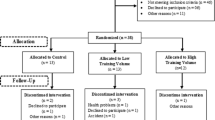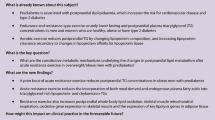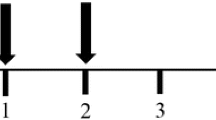Abstract
The aim of this study was to investigate the acute effects of resistance exercise sessions (RESs) performed at different levels of high-volume resistance exercise (HVRE) and low-volume resistance exercise (LVRE) on postprandial lipemia (PPL) in postmenopausal women. Thirty-nine healthy unconditioned postmenopausal women (59.5 ± 4.8 years of age, body mass 69.6 ± 9.1 kg, height 157.9 ± 7.2 cm, BMI 27.6 ± 4.1 kg m−2, waist circumference 76.1 ± 9.7 cm, VO2max 18.7 ± 1.4 mL kg−1 min−1) were assigned to a LVRE (n = 12), HVRE (n = 14), and control group (CG, n = 13). Experimental groups performed one RES involving eight exercises. The HVRE group performed three sets with a maximum of 15 repetitions, and the LVRE group performed one set with a maximum of 15 repetitions. Approximately 16 h after a RES, all of the groups were given an oral fat tolerance test (OFTT). During the RES, we evaluated the energy expenditure (EE) of the resistance session and excess postexercise oxygen consumption (EPOC); following the RES and the OFTT, we evaluated lipid profiles (total cholesterol, HDL, LDL, and triglycerides). While the study groups did not demonstrate significant differences in lipid profiles, the total energy expenditure (EE + EPOC) of the session exercise treatments was significantly higher for HVRE than for LVRE (0.60 ± 0.12 and 0.31 ± 0.11 MJ, respectively, p < 0.001). Different levels of resistance exercise do not lower basal triglyceride concentration and postprandial lipid profile parameters at approximately 16 h following resistance exercise in untrained postmenopausal women.



Similar content being viewed by others
References
Ainsworth BE, Haskell WL, Whitt MC, Irwin ML, Swartz AM, Strath SJ, O’Brien WL, Bassett DR Jr, Schmitz KH, Emplaincourt PO, Jacobs DR Jr, Leon AS (2000) Compendium of physical activities: an update of activity codes and MET intensities. Med Sci Sports Exerc 32:S498–S504
Aldred HE, Perry IC, Hardman AE (1994) The effect of a single bout of brisk walking on postprandial lipemia in normolipidemic young adults. Metab Clin Exper 43:836–841
American College of Sports Medicine Position Stand (2009) The recommended quantity and quality of exercise for developing and maintaining cardiorespiratory and muscular fitness, and flexibility in healthy adults. Med Sci Sports Exerc 30:975–991
Ballor DL, Poehlman ET (1992) Resting metabolic rate and coronary-heart-disease risk factors in aerobically and resistance-trained women. Am J Clin Nutr 56:968–974
Bianco A, Pomara F, Jemni M, Paoli A, Petrucci M, Bellafiore M, Palma A (2011) Influence of family history of NIDDM on basal metabolic rate in sedentary and active women. Pan Med 53:253–259
Binzen CA, Swan PD, Manore MM (2001) Postexercise oxygen consumption and substrate use after resistance exercise in women. Med Sci Sports Exerc 33:932–938
Burns SF, Stensel DJ (2008) Effects of low- and high-volume resistance exercise on postprandial lipemia: comments by Burns and Stensel. Br J Nutr 99:211, discussion 212-213
Burns SF, Corrie H, Holder E, Nightingale T, Stensel DJ (2005) A single resistance exercise session does not reduce postprandial lipemia. J Sports Sci 23:251–260
Cefalu WT (2012) American Diabetes Association-European Association for the Study of Diabetes position statement: due diligence was conducted. Diab Care 35:1201–1203
Chapman J, Garvin AW, Ward A, Cartee GD (2002) Unaltered insulin sensitivity after resistance exercise bout by postmenopausal women. Med Sci Sports Exerc 34:936–941
Correa CS, Laroche DP, Cadore EL, Reischak-Oliveira A, Bottaro M, Kruel LF, Tartaruga MP, Radaelli R, Wilhelm EN, Lacerda FC, Gaya AR, Pinto RS (2012) 3 Different types of strength training in older women. Int J Sports Med 33:962–969
Cunha G, Lorenzi T, Sapata K, Lopes AL, Gaya AC, Oliveira A (2011) Effect of biological maturation on maximal oxygen uptake and ventilatory thresholds in soccer players: an allometric approach. J Sports Sci 29:1029–1039
Davitt PM, Arent SM, Tuazon MA, Golem DL, Henderson GC (2013) Postprandial triglyceride and free fatty acid metabolism in obese women after either endurance or resistance exercise. J Appl Physiol 114:1743–1754
Dekerle J, Baron B, Dupont L, Vanvelcenaher J, Pelayo P (2003) Maximal lactate steady state, respiratory compensation threshold and critical power. Eur J Appl Physiol 89:281–288
Gill JM, Hardman AE (2000) Postprandial lipemia: effects of exercise and restriction of energy intake compared. Am J Clin Nutr 71:465–471
Gill JM, Herd SL, Hardman AE (2002) Moderate exercise and post-prandial metabolism: issues of dose-response. J Sports Sci 20:961–967
Graham TE (2004) Exercise, postprandial triacylglyceridemia, and cardiovascular disease risk. Can J Appl Physiol 29:781–799
Henry CJ, Lightowler HJ, Marchini J (2003) Intra-individual variation in resting metabolic rate during the menstrual cycle. Brit J Nutr 89:811–817
Hurley BF, Hagberg JM, Goldberg AP, Seals DR, Ehsani AA, Brennan RE, Holloszy JO (1988) Resistive training can reduce coronary risk factors without altering VO2max or percent body fat. Med Sci Sports Exerc 20:150–154
Kanaya AM, Herrington D, Vittinghoff E, Lin F, Grady D, Bittner V, Cauley JA, Barrett-Connor E (2003) Glycemic effects of postmenopausal hormone therapy: the Heart and Estrogen/Progestin Replacement Study. A randomized, double-blind, placebo-controlled trial. An Internal Med 138:1–9
Mamo JC, Proctor SD, Smith D (1998) Retention of chylomicron remnants by arterial tissue; importance of an efficient clearance mechanism from plasma. Atheroscl 141(Suppl 1):S63–S69
Marfell-Jones TS, A. (2006) International standards for anthropometric assessment. International Society for the Advancement of Kinanthropometry (ISAK)
McConnell AK, Copestake AJ (1999) Maximum static respiratory pressures in healthy elderly men and women: issues of reproducibility and interpretation. Resp Int Rev Thor Dis 66:251–258
Petitt DS, Cureton KJ (2003) Effects of prior exercise on postprandial lipemia: a quantitative review. Metab Clin Exp 52:418–424
Petitt DS, Arngrimsson SA, Cureton KJ (2003) Effect of resistance exercise on postprandial lipemia. J Appl Physiol 94:694–700
Poehlman ET, Dvorak RV, DeNino WF, Brochu M, Ades PA (2000) Effects of resistance training and endurance training on insulin sensitivity in nonobese, young women: a controlled randomized trial. J Clin Endocrinol Metab 85:2463–2468
Ratamess NA, Falvo MJ, Mangine GT, Hoffman JR, Faigenbaum AD, Kang J (2007) The effect of rest interval length on metabolic responses to the bench press exercise. Eur J Appl Physiol 100:1–17
Shannon KA, Shannon RM, Clore JN, Gennings C, Warren BJ, Potteiger JA (2005) Resistance exercise and postprandial lipemia: the dose effect of differing volumes of acute resistance exercise bouts. Metab Clin Exp 54:756–763
Shimano T, Kraemer WJ, Spiering BA, Volek JS, Hatfield DL, Silvestre R, Vingren JL, Fragala MS, Maresh CM, Fleck SJ, Newton RU, Spreuwenberg LP, Hakkinen K (2006) Relationship between the number of repetitions and selected percentages of one repetition maximum in free weight exercises in trained and untrained men. J Strength Cond Res 20:819–823
Singhal A, Trilk JL, Jenkins NT, Bigelman KA, Cureton KJ (2009) Effect of volume of resistance exercise on postprandial lipemia. J Appl Physiol 106:823–829
Smutok MA, Reece C, Kokkinos PF, Farmer C, Dawson P, Shulman R, DeVane-Bell J, Patterson J, Charabogos C, Goldberg AP, Hurley BF (1993) Aerobic versus strength training for risk factor intervention in middle-aged men at high risk for coronary heart disease. Metab Clin Exp 42:177–184
Szczypaczewska M, Nazar K, Kaciuba-Uscilko H (1989) Glucose tolerance and insulin response to glucose load in body builders. Int J Sports Med 10:34–37
Takagi H, Umemoto T (2011) The specter of publication bias: adjustment for publication bias in the evidence on cardiac death associated with passive smoking in nonsmoking women. Inter J Cardiolog 149:388–389
Thornton MK, Potteiger JA (2002) Effects of resistance exercise bouts of different intensities but equal work on EPOC. Med Sci Sports Exerc 34:715–722
Treuth MS, Hunter GR, Weinsier RL, Kell SH (1995) Energy expenditure and substrate utilization in older women after strength training: 24-h calorimeter results. J Appl Physiol 78:2140–2146
Tsetsonis NV, Hardman AE, Mastana SS (1997) Acute effects of exercise on postprandial lipemia: a comparative study in trained and untrained middle-aged women. Am J Clin Nutr 65:525–533
Tzankoff SP, Norris AH (1977) Effect of muscle mass decrease on age-related BMR changes. J Appl Physiol 43:1001–1006
Yarasheski KE, Tebas P, Stanerson B, Claxton S, Marin D, Bae K, Kennedy M, Tantisiriwat W, Powderly WG (2001) Resistance exercise training reduces hypertriglyceridemia in HIV-infected men treated with antiviral therapy. J Appl Physiol 90:133–138
Zafeiridis A, Goloi E, Petridou A, Dipla K, Mougios V, Kellis S (2007) Effects of low- and high-volume resistance exercise on postprandial lipemia. Brit J Nutr 97:471–477
Zaman GS, Rahman S, Rahman J (2012) Postprandial lipemia in pre- and postmenopausal women. J Nat Sci Biol Med 3:65–70
Conflict of interest
The authors declare that they have no conflict of interest.
Ethics statement
All of the participants gave their written informed consent to participate in the study, which was approved by the Human Ethics Committee of the Federal University of Rio Grande do Sul and conformed to current laws for such research conducted in Brazil.
Author information
Authors and Affiliations
Corresponding author
About this article
Cite this article
Correa, C.S., Teixeira, B.C., Macedo, R.C.O. et al. Resistance exercise at variable volume does not reduce postprandial lipemia in postmenopausal women. AGE 36, 869–879 (2014). https://doi.org/10.1007/s11357-013-9610-3
Received:
Accepted:
Published:
Issue Date:
DOI: https://doi.org/10.1007/s11357-013-9610-3




